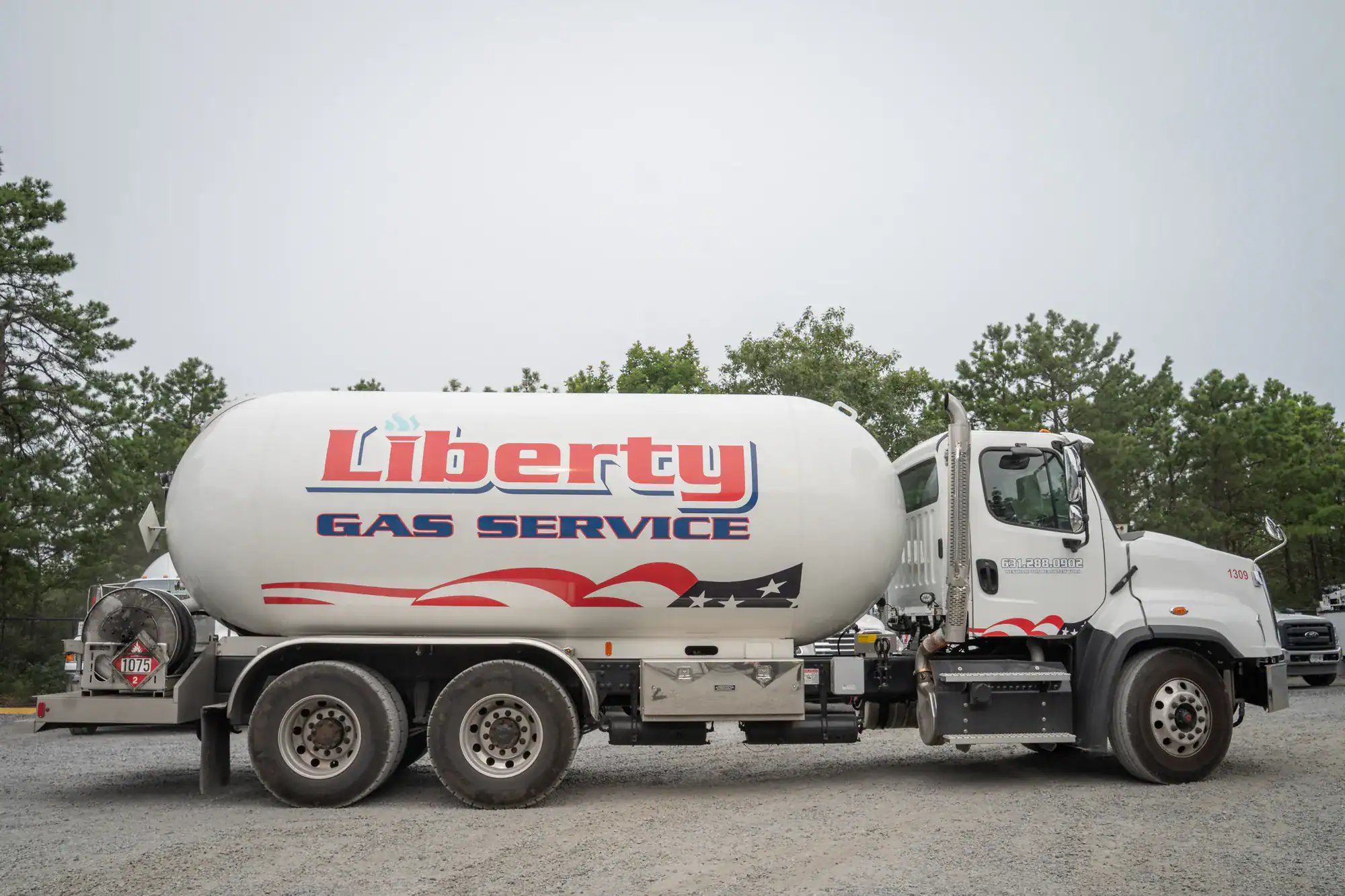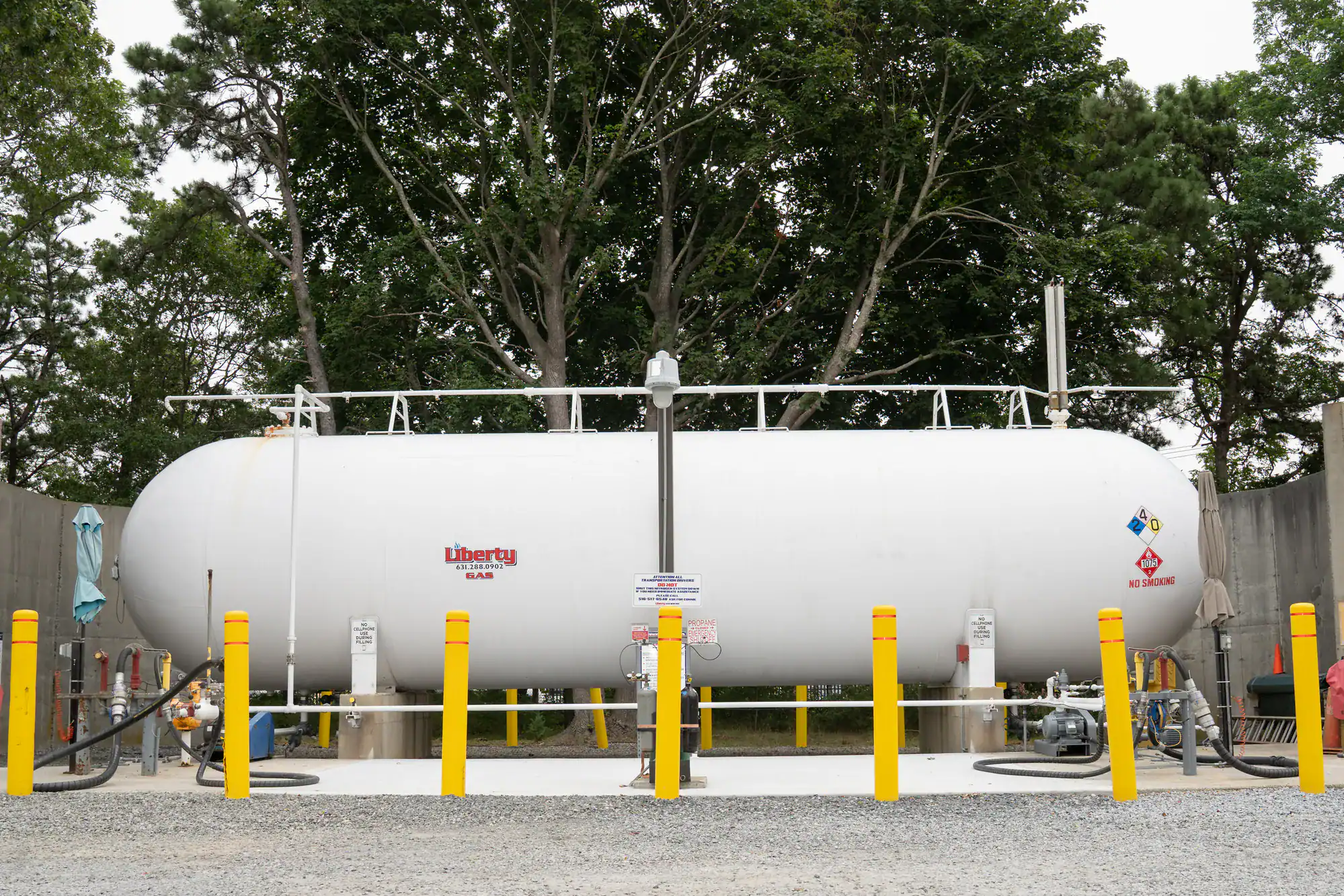Summary:
Understanding Propane Tank Sizes for Residential Use
The size of your propane tank will depend on the size of your home as well as the number and size of appliances using propane. Most Suffolk County homeowners fall into predictable usage patterns that make sizing straightforward.
A 500-gallon tank should do the job for most households, but that’s not always the complete picture. Your actual needs depend on what you’re powering and how often you use it.
The key is matching tank capacity to your consumption patterns rather than guessing or going with what seems “standard.”
Common Residential Tank Sizes and Their Applications
Let’s break down the most common residential propane tank sizes and what they’re actually designed to handle in real-world Suffolk County homes.
A standard 120-gallon propane tank is primarily designed for homes or businesses that are only running 1-2 appliances on propane, including hot water heaters, fireplaces, home appliances, or space heaters. Think of this as your starter size—perfect if you’re only running a water heater and maybe a fireplace.
The standard size for most households, a 500-gallon tank is perfect for powering central heating, appliances, and even small commercial projects. This handles whole-home heating plus multiple appliances without constantly running low.
Generally reserved for large industrial and commercial projects, 1,000-gallon tanks also work well for larger homes. If your Suffolk County home is over 4,500 square feet or you’re running extensive propane systems, this might be your sweet spot.
The 250-gallon option sits between the 120 and 500-gallon tanks. Uses: Supplemental heating or 2 home appliances including water heaters, generators, and pool heaters. A 250-gallon propane tank holds 200 gallons of propane when full. This works well for homes that need more than basic coverage but aren’t quite ready for the 500-gallon commitment.
Here’s what matters most: your tank size should align with your peak usage periods, not your average consumption. Suffolk County winters can be brutal, and running out of propane when temperatures drop isn’t just inconvenient—it’s dangerous.
Calculating Your Actual Propane Needs
Forget the generic calculators you find online. Your Suffolk County property has specific considerations that affect your propane consumption in ways those tools don’t account for.
Start with your primary heating system. If propane is your main heat source, full service residential customers typically use approximately 1,100 or more gallons of propane annually. That’s your baseline for homes with central propane heating.
Add your other appliances systematically. A propane water heater typically uses 200-300 gallons per year for an average family. Cooking ranges use about 35-50 gallons annually. Pool heaters can consume 300-500 gallons during swimming season, which in Suffolk County might be longer than you think.
Your geographical location and local climate can also play a role in choosing your propane tank size. For example, a tank for heating in milder climates may not need to be as big as a tank for heating in a colder climate. Suffolk County’s coastal location means you’re dealing with both cold winters and humid summers—both affect your consumption patterns.
Don’t forget backup power. Many Suffolk County residents rely on propane generators during storm season. A standby generator can use 2-3 gallons per hour during operation. If you’re planning for extended outages, factor this into your calculations.
The smart approach is calculating your peak winter month usage, then ensuring your tank can handle at least 1.5 times that amount. This gives you buffer for unusually cold periods and reduces the stress of monitoring levels constantly.
Your local usage patterns matter too. Hamptons residents might have seasonal spikes during summer entertaining season, while year-round residents see their heaviest usage during January and February heating demands.
Commercial Propane Tank Sizing Guidelines
Commercial propane needs in Suffolk County vary dramatically depending on your business type, but the sizing principles remain consistent. You need enough capacity to handle peak demand periods without frequent deliveries disrupting operations.
We often install these larger systems in apartment complexes, hotels, restaurants, and industrial facilities where substantial tank systems become essential for uninterrupted service.
Commercial sizing starts with understanding your demand patterns rather than just calculating total consumption.
Restaurant and Food Service Applications
Restaurants and food service businesses in Suffolk County have unique propane demands that require careful tank sizing consideration. Your peak usage happens during service hours, not spread evenly throughout the day.
A typical restaurant uses propane for cooking equipment, water heating, and sometimes space heating. Commercial cooking equipment can consume 80-120 gallons per month per burner during heavy use periods. Restaurants serving 100+ customers daily often need 500-1000 gallon systems to avoid service interruptions.
Consider your busiest periods. Summer restaurants in the Hamptons might see 300% usage spikes during peak season, while year-round establishments have steadier but still significant consumption patterns. Your tank sizing needs to handle these peaks without running low during critical service times.
Water heating in commercial kitchens is often overlooked but represents significant consumption. Commercial dishwashers and prep sinks can use 200-400 gallons monthly depending on volume and water temperature requirements.
Don’t forget about backup systems. Many Suffolk County restaurants install backup propane systems for power outages, especially during storm season when losing refrigeration could mean losing thousands in inventory.
The key is sizing for your absolute peak demand plus 20-30% buffer. Running out of propane during dinner service isn’t just inconvenient—it can shut down your entire operation and damage your reputation.
Multi-Unit and Commercial Building Requirements
Multi-unit residential buildings and larger commercial properties in Suffolk County require different approaches to propane tank sizing. You’re not just scaling up residential needs—you’re dealing with simultaneous demand from multiple units or systems.
For larger residential and commercial applications, tanks with a capacity of 500-gallons or more are required. These tank sizes are typically buried underground and provide fuel for extensive heating systems, larger appliances, and commercial operations. Underground installation becomes almost mandatory at this scale for both safety and space efficiency.
Calculate simultaneous demand carefully. While a 20-unit apartment building might theoretically need 20 times a single-unit consumption, actual usage patterns mean you can often size for 60-70% of theoretical maximum. Not every unit uses peak propane at exactly the same time.
Consider your building’s usage patterns. Office buildings have predictable 9-5 demand curves. Apartment complexes see morning and evening peaks. Hotels have seasonal variations that can be extreme in Suffolk County’s tourist areas.
Factor in common area heating, laundry facilities, pool heating, and any commercial spaces within the building. These add significant consumption that’s easy to overlook during initial sizing calculations.
Installation becomes more complex with larger systems. Where a single LP-gas container is more than 2,000 gallons in water capacity or the aggregate water capacity of LP-gas containers is more than 4,000 gallons, the installer must submit construction documents for such installation. Suffolk County requires additional permits and inspections for these larger installations.
The smart approach for commercial properties is working with experienced propane professionals who understand local regulations and can properly size systems for your specific application. Undersizing means service interruptions. Oversizing means wasted capital and ongoing costs for unused capacity.
Making the Right Choice for Your Suffolk County Property
Choosing the right propane tank size comes down to understanding your actual usage patterns, local requirements, and planning for peak demand periods. Selecting the appropriate propane tank size is crucial to ensure an uninterrupted and efficient fuel supply for your specific needs. Whether you’re planning a weekend camping trip or looking to power your entire home, understanding the common uses associated with different tank sizes will help you make an informed decision.
The investment in proper sizing pays for itself through reduced delivery costs, better efficiency, and peace of mind during Suffolk County’s demanding winter months. Don’t guess on something this important to your comfort and safety.
For expert tank sizing, installation, and ongoing service in Suffolk County, we bring the local knowledge and professional expertise to get your propane system right the first time.



